
I have been teaching writing at the college level for over six years to both first and second language learners. Unless I am teaching EAP, where my students are second language learners, my classes have been mixed: native language students at various language levels and experiences as well as non-native language learners, including 1.5 generation (people who immigrate to a new country before or during their early teens) with different levels of language proficiency. Note that no matter who the students are, my job is to help my students achieve the learning outcomes of the course (e.g. to be able to write an academic essay), which means I must pay attention and therefore take into consideration each student’s individual needs. How do I reconcile all these differences in a writing course? Well, among many teaching strategies, I focus on selective attention.
Selective Attention
According to Richard Schmidt (2010) our ability to focus is dependent on our awareness of the existence of stimuli. It is difficult (even impossible) to pay attention to every bit of information around us, so we need to be consciously aware it exists to be able to notice it. Hence, not knowing what to focus our attention on can leave us paying attention to unimportant information, unaware of what it is we should be focusing on! This is one reason why in our training, we are advised to make content relevant to our students. By doing so, we help our students make connections (associations) with new material, retain it in long term memory, and as a result, utilize it in everyday life (transferable skills). It makes sense. In second language theory, this idea is known as “awareness raising” in the Noticing Hypothesis posed by Schmidt (1990, 2001, 2010). To me, selective attention and awareness raising help me reconcile the needs of a truly diverse classroom. By practicing these concepts, I help my all my students gain the strategies to start noticing how their writing addresses a question, a topic, an audience, or a purpose. This is a great challenge – one I look forward to – as I sink my teeth into incorporating first and second language writing theories into my lessons so everyone can benefit. Let me share my strategy:
Free Writing
The free writing opportunities in my classroom are all geared to meeting learning outcomes, while providing students with stress-free writing practice (no grades, just my feedback to allow students to notice their strengths and areas for improvement). Since these free writing tasks are usually in response to a question related to a reading or theme (the latter requiring the analyses of more than one reading), the only restriction is that students must start their free-writing by answering the question posed. Note that by the time students are ready to free write, they would have already gone through a series of intensive reading strategies (repeated exposure, discussion, vocabulary, meaning and intention, and structural analyses). The idea is for students to own the material through repetitive exposure. Noticing therefore begins in the reading stage as students know that even though their free writing is not graded, the process of reading and free-writing is the first step to the writing process, which will ultimately take the form of a graded, analytical essay. What comes next? After students receive my feedback, they move on to writing a comprehensive outline.
The Comprehensive Outline
This stage is meant to help students identify the main ideas they will incorporate in their graded essay and choose support from the reading or readings. The rule for this stage is to focus on answering the question, so each chosen example (evidence) can only be used once, must be cited, and its relevance must be explained in one sentence. The comprehensive outline is graded (e.g. 5% of the total essay mark of 20%). It is low stakes, and offers students another opportunity to notice their strengths and improve on weak areas (organization, content analysis, citation style, grammar, and mechanics) as I give them feedback before they move on to writing the final product.
The Final Product
What a joy it is for me to read students’ final product when they have gone through the process. I have found that students who go through the process benefit greatly, while those who skip a step or the entire process…well, they still need to notice and pay attention.
What are some of your strategies to help students become better writers? Please share in the comments below.
__________________________________________________________________________
For an in-depth look at Schmidt’s “awareness raising” please check out the following sources:
Schmidt, R. (1990). The role of consciousness in second language learning. Applied Linguistics, 11, 129-158.
Schmidt, R. (2001). Attention. In P. Robinson (Ed.), Cognition and second language instruction (pp. 3-32). Cambridge: Cambridge University Press.
Schmidt, R. (2010). Attention, awareness, and individual differences in language learning. In W. M. Chan, S. Chi, K. N. Cin, J. Istanto, M. Nagami, J. W. Sew, T. Suthiwan, & I. Walker, Proceedings of CLaSIC 2010, Singapore, December 2-4 (pp. 721-737). Singapore: National University of Singapore, Centre for Language Studies.
